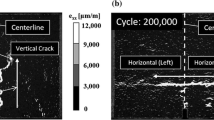Abstract
This paper investigates the damage characteristics of a lightly stabilized granular material using cyclic load flexural testing with an improved deflection measurement setup. Beam specimens were prepared from a typical granular base material lightly stabilised with 1.5 % cement-flyash, cured for 28 days and tested at different stress ratios (SRs) until the fracture occurred. Fatigue life was established as the number of cycles required to break the specimen under stress-controlled cyclic loading at a frequency of 3 Hz. Fatigue induced damage was evaluated using the dissipated energy approach. Experimental results indicated that damage accumulation due to fatigue approximately follows the Miner’s linear cumulative damage rule. The study also found that the accumulated permanent deformation of lightly stabilised materials showed good correlation with number of load cycles and the developed empirical equations at different SRs can be used to predict the fatigue life. Progressive damage accumulation due to permanent deformation with increases in the load cycles is also presented in this study.









Similar content being viewed by others
References
Arulrajah A, Disfani MM, Haghighi H, Mohammadinia A, Horpibulsuk S (2015). Modulus of rupture evaluation of cement stabilized recycled glass/recycled concrete aggregate blends. Constr Build Mat 84:146–155
AS 1289.5.1.1 (2003) Methods of testing soils for engineering purposes, method 5.1.1: soil compaction and density tests—determination of the dry density/moisture content relation of a soil using standard compactive effort. Standards Australia, Sydney
ASTM D698–07 (2007) Test method for laboratory compaction characteristics of soil using standard effort [12 400 ft-lbf/ft3 (600 kN-m/m3)], annual book of ASTM Standards, vol 04.08. ASTM International, Conshohocken
ASTM D1241–07 (2007) Specification for materials for soil-aggregate subbase, base and surface courses, annual book of ASTM Standards, vol 04.08. ASTM International, Conshohocken
ASTM C1609–10 (2010) Standard test method for flexural performance of fiber-reinforced concrete (using beam withn third-point loading), annual book of ASTM Standards, vol 04.08. ASTM International, Conshohocken
ASTM D1632–07 (2007) Standard practice for making and curing soil—cement compression and flexure test specimens in the laboratory, annual book of ASTM Standards, vol 04.08. ASTM International, Conshohocken
Austroads (2010) Guide to pavement technology—Part 2: pavement structural design. AUSTROADS, Sydney
Behzadi G, Yandell WO (1996) “Determination of Elastic and Plastic Subgrade Soil Parameters for Asphalt Cracking and Rutting Prediction, vol 1540. Transportation Research Board, Washington, pp 97–104
Bhogal BS, Coupe PS, Davies J, Fendukly LM (1995) Dynamic flexure tests of soil-cement beams. J Mater Sci Lett 14:302–304
Disfani MM, Arulrajah A, Haghighi H, Mohammadinia A, Horpibulsuk S (2014) Flexural beam fatigue strength evaluation of crushed brick as a supplementary material in cement stabilized recycled concrete aggregates. Constr Build Mat 68:667–676
Diyaljee VA, Raymond GP (1982) Repetitive load deformation of cohesionless soil. J Geotech Eng Div ASCE 108(10):1215–1229
Foley G, Australian Stabilisation Expert Group (2001) Contract report—effect of design, construction and environmental factors for long-term performance of stabilised materials, Report No. RC91022-1, Austroads, Sydney, Australia
Fu P, Jones D, Harvey JT, Bukhari SA (2009) Laboratory test methods for foamed asphalt mix resilient modulus. Road Mater Pavement Des 10(1):187–212
Gnanendran CT, Piratheepan J (2010) Determination of fatigue life of a granular base material lightly stabilized with slag lime from indirect diametral tensile testing. J Transp Eng 136(8):736–745
Grzybowski M, Meyer C (1993) Damage accumulation in concrete with and without fiber reinforcement. ACI Mater J 90(6):594–604
Khoury NN, Zaman MM (2006) Durability effects on flexural behaviour of fly ash stabilised limestone aggregate. J Test Eval 34(3):167–175
Kim DJ, Naaman AE, El-Tawil S (2008) Comparative flexural behaviour of four fiber reinforced cementitious composites. Cement Concr Compos 30(10):917–928
Lin C, Kayali O, Morozov EV, Sharp DJ (2011) Deflection hardening of steel fibre reinforced cementitious composites with high volume fly ash. In: Proceedings of the 9th International Symposium on HPC, Rotorua, New Zealand, pp 1–8
Miner MA (1945) Cumulative damage in fatigue. J Appl Mech T ASME 12(3):A159–A164
Moffat MA, Yeo EEY (1998) Relationship between unconfined compressive strength and flexural modulus for cemented materials. TR Working Document No. R-98/024, ARRB, Melbourne, Australia
Murdock JW, Kesler CE (1958) Effect of range of stress on fatigue strength of plain concrete beams. ACI J 55(2):221–232
NCHRP (2004) Final report—guide for mechanistic-empirical design of new and rehabilitated pavement design structures—part 2 design inputs—chapter 2: material characterization, ERES Division of ARA, Inc., Champaign
Paul D, Gnanendran C (2012) Prediction of nonlinear stress–strain relationship of lightly stabilized granular materials from unconfined compression testing. J Mater Civ Eng 24(8):1118–1124
Paul DK, Gnanendran CT (2012b) Characterisation of lightly stabilised granular base materials by flexural beam testing and effects of loading rate. ASTM Geotech Test J 35(5)
Paul DK, Gnanendran CT (2013) Stress–strain behaviour and stiffness of lightly stabilised granular materials from UCS testing and their predictability. Int J Pavement Eng 14(3):291–308
Paul DK, Gnanendran CT, Piratheepan J (2010) Determination of stiffness properties of lightly stabilised granular materials from IDT testing using numerical analysis. In: Proceeding of the 17th Southeast Asian Geotechnical Conference, Taiwan Geotechnical Society and Southeast Asian Geotechnical Society, vol 1, pp 75–78
Paul DK, Gnanendran CT (2011) Effect of loading rate on the properties of lightly stabilized granular materials by using flexural beam testing. In: 14th Pan-American—CGS Conference on Soil Mechanics and Geotechnical Engineering, Pan-Am CGS 2011 Organizing Committee, 2–6 October, 2011, Toronto, Canada
Sobhan K, Das BM (2007) Durability of soil-cements against fatigue fracture. J Mater Civ Eng 19(1):26–32
Swanson TE, Thompson MR (1967) Flexural fatigue strength of lime-soil mixtures, vol 198. Highway Research Records, Highway Research Board, National Research Council, Washington, pp 9-18
Acknowledgments
The authors would like to thank Mr. David Sharp, Mr. Jim Baxter and Mr. Mathew Barret for their technical assistance during the experimental work reported in this paper.
Author information
Authors and Affiliations
Corresponding author
Rights and permissions
About this article
Cite this article
Paul, D.K., Theivakularatnam, M. & Gnanendran, C.T. Damage Study of a Lightly Stabilised Granular Material Using Flexural Testing. Indian Geotech J 45, 441–448 (2015). https://doi.org/10.1007/s40098-015-0158-2
Received:
Accepted:
Published:
Issue Date:
DOI: https://doi.org/10.1007/s40098-015-0158-2




